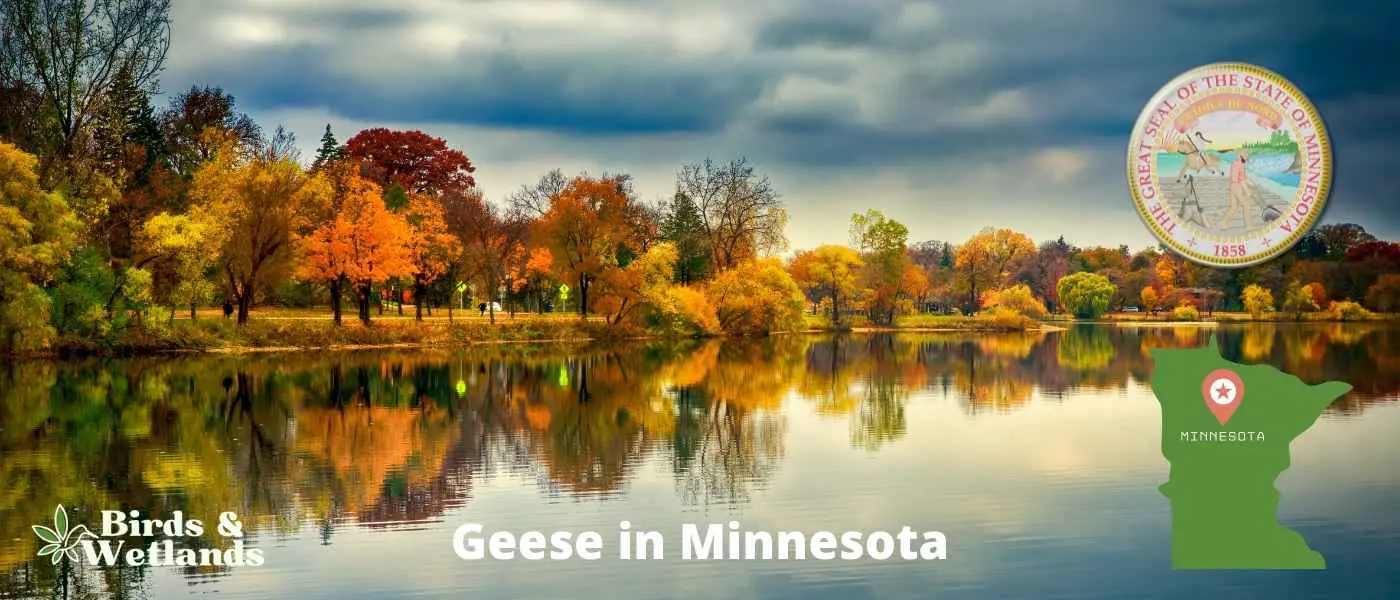Minnesota is home to a wide variety of birds, including several species of geese. Geese can be seen in many parts of the state, but they are particularly common in the central and southern regions.
What Geese Are in Minnesota?
There are five goose species and three swan species in Minnesota.
- Canada Goose
- Snow Goose
- Ross’s Goose
- Cackling
- Greater White-fronted Goose
Swan species in Minnesota include Tundra Swan, Trumpeter Swan and Mute Swan.
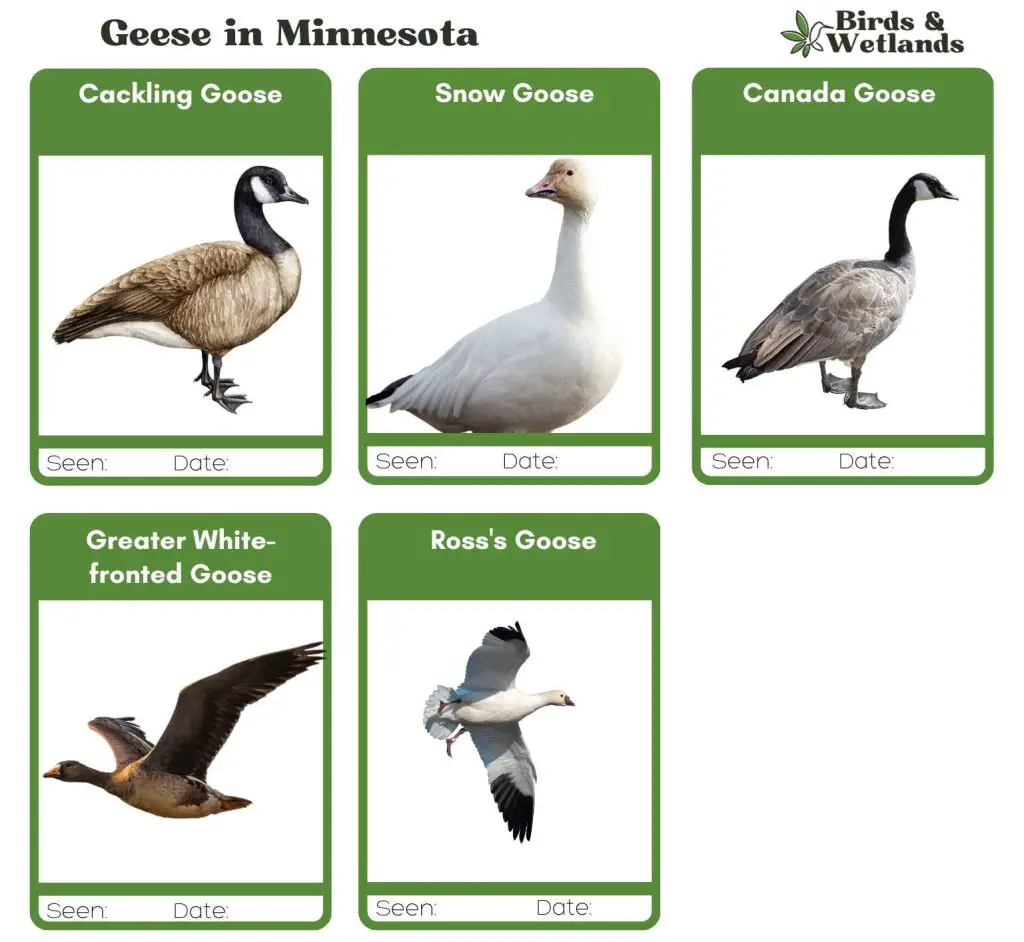
Canada Goose


Canada Goose Sound
Scientific Name: Branta canadensis
Length: 30 to 43 in
Wingspan: 50–73 in
Weight: 5.7–14.3 lb
The Canada Goose is a large, well-known species of waterfowl noted for its distinctive appearance, familiar “honk,” and migratory behavior.
Appearance: Both male and female Canada Geese have a similar appearance, featuring a black head and neck with distinctive white patches on the cheeks and chin. The body is primarily brown with a lighter, often white, underbelly.
Diet: Canada Geese primarily feed on plant matter, including grasses, aquatic vegetation, and grains. They can often be seen grazing in parks, lawns, and fields, as well as dabbling in water bodies.
Reproduction: Canada Geese typically nest on the ground near water bodies, often on islands or other isolated areas to avoid predators. The female lays a clutch of about 4 to 6 eggs, which she incubates alone for around a month.
Snow Goose

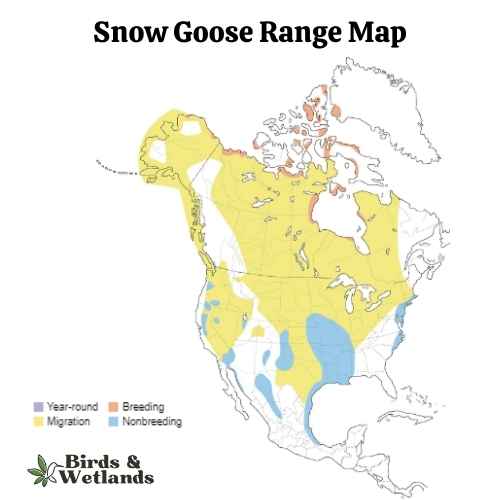
Snow Goose Sound
Scientific Name: Anser caerulescens
Length: 25 to 31 in
Wingspan: 53 to 65 in
Weight: 4.5 to 6.0
The Snow Goose is a large species of waterfowl known for its vibrant white plumage and significant migratory flights.
Appearance: True to their name, Snow Geese are predominantly white with black wingtips. They also have a pink bill, pink legs and feet. A color morph, known as the “Blue Goose,” displays a bluish-gray body with a white head, but is considered the same species.
Diet: Snow Geese primarily feed on plant matter, such as grasses, sedges, and small grains. They can often be seen in large flocks foraging in fields and marshes, and during migration and winter, they can cause considerable damage to agricultural fields due to their feeding habits.
Reproduction: Snow Geese typically nest on the tundra, near water bodies. The female builds the nest and lays a clutch of about 3 to 5 eggs, which she incubates alone for approximately three weeks. Once hatched, the goslings can feed themselves but stay with their parents for protection until they can fly.
Ross’s Goose
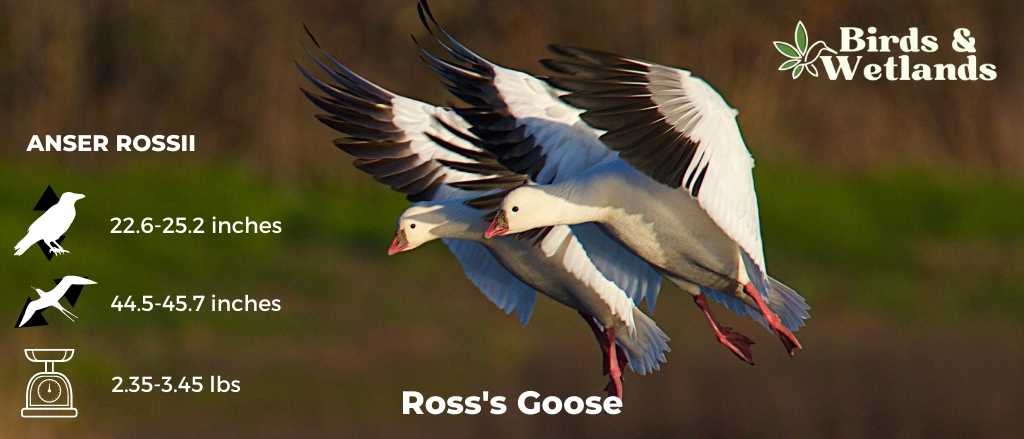
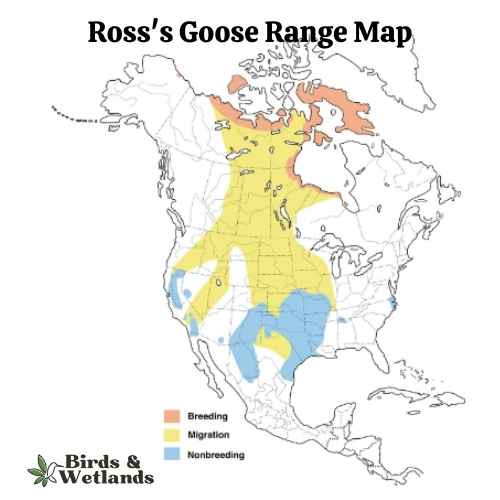
Listen
Scientific Name: Anser rossii
Length: 23.2-25.2
Wingspan: 44.5-45.7 in
Weight:42.3-55.3 oz
The Ross’s Goose is a small species of waterfowl often found in North America’s tundra and wetland habitats.
Appearance: Known for its compact size, the Ross’s Goose is mostly white with black wingtips. It features a short, stubby bill and a rounded head. One key identifying feature is the blueish gray base of its bill, which has a warty structure during the breeding season.
Diet: This goose feeds mainly on vegetation, including seeds, leaves, and roots of grasses and sedges. During winter and migration, they also consume grains and seeds from agricultural fields.
Reproduction: The Ross’s Goose nests on the ground, often in colonies. The female lays a clutch of 2 to 5 eggs which she incubates for around three weeks. The young geese, known as goslings, are precocial – they can walk, swim, and feed themselves shortly after hatching, although they stay with their parents until they learn to fly.
Cackling Goose
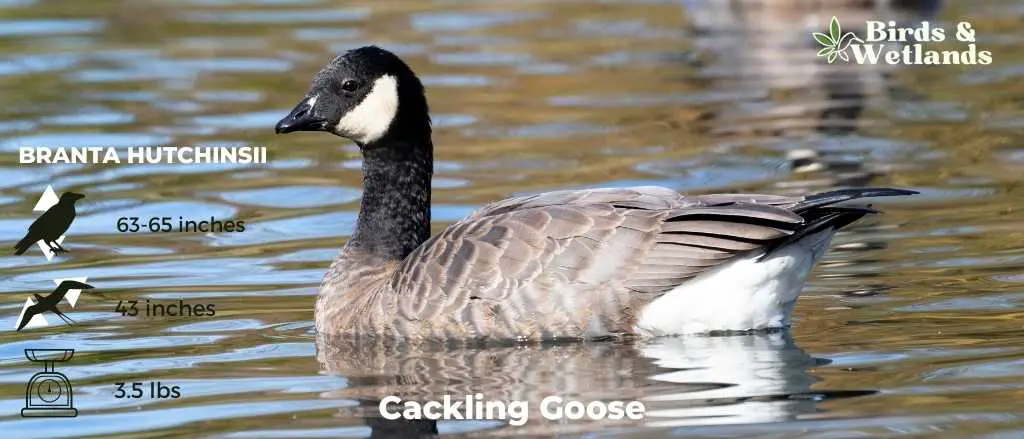
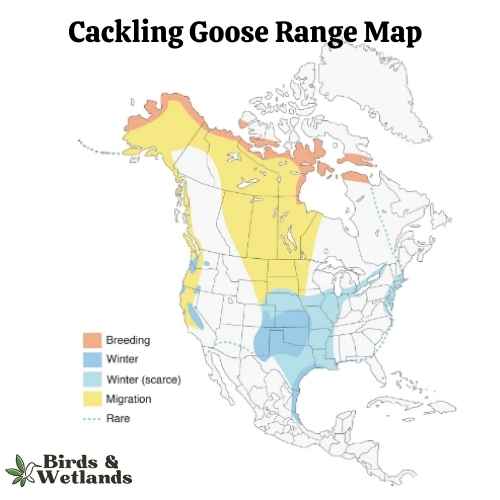
Listen
Scientific Name: Branta hutchinsii
Length: 24.8–25.6 in
Wingspan: 43-45.7 in
Weight:3.5 lbs
Cackling Geese are particularly known for their high-pitched, cackling calls, which is the source of their name. Despite their small size, these geese are renowned long-distance migrants, with some populations traveling thousands of miles between breeding and wintering grounds.
Appearance: With a similar color pattern to the larger Canada Goose, the Cackling Goose features a black head and neck, white chinstrap, light tan to cream chest, and brownish-grey body. One defining characteristic is its noticeably smaller size and stubbier neck compared to its larger counterparts.
Diet: Like many geese, the Cackling Goose’s diet mainly consists of plant matter. This includes grasses, seeds, and aquatic vegetation. They are often seen grazing on land or dabbling in shallow water.
Reproduction: Cackling Geese usually nest on the ground in elevated areas near water bodies, such as riverbanks or lakeshores. The female lays a clutch of 2 to 8 eggs and is responsible for incubation, while the male stands guard nearby. Incubation lasts for about a month.
Greater White-fronted Goose
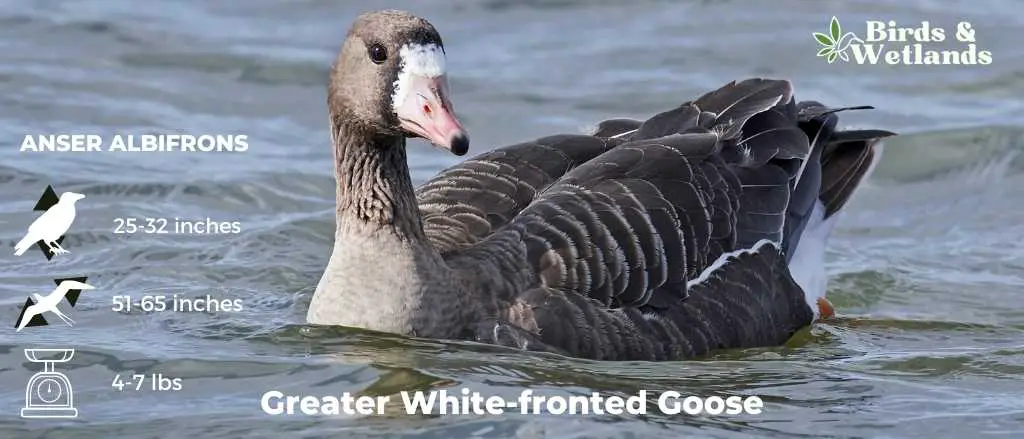

Listen
Scientific Name: Anser albifrons
Length: 25 to 31 in
Wingspan: 53 to 66 in
Weight: 3.3 to 6.6
The Greater White-fronted Goose is a medium to large waterfowl species, widely distributed across the Northern Hemisphere, particularly in North America.
Appearance: As the name suggests, these geese display a prominent white patch at the base of their bill. Their bodies are gray-brown, and their breasts are often marked with dark blotches. They possess a pinkish bill and orange legs and feet.
Diet: The Greater White-fronted Goose is a herbivore and feeds mainly on plant material. Its diet consists of grasses, sedges, grains, and berries. When wintering, these geese can often be found in agricultural fields, feasting on leftover grains and crops.
Reproduction: This species nests on the ground, often in areas with good visibility such as slopes or ridges. The female lays a clutch of 4 to 5 eggs, which she incubates for nearly a month. Once hatched, the young ones are taken care of by both parents until they are able to fly.
Are There Any Resident Flocks of Geese In Minnesota?
Minnesota is well-known for its abundance of lakes, and it turns out that these bodies of water are the perfect habitats for Canada geese.
In recent years, Canada goose populations have exploded in the state, particularly in southern Minnesota.
According to the Minnesota Department of Natural Resources, there are more than 300,000 Canada geese in Minnesota, 25,000 of these geese are estimated to live in the Twin Cities area.
While most of these geese are migratory, there is a growing population of resident geese who have chosen to make Minnesota their year-round home.
These geese have built their nests in natural areas as well as man-made ones such as golf courses. These resident giant Canada geese tend to be less wary of humans and can often be seen grazing in parks and along busy city streets.
Hunting Geese in Minnesota
Hunting season is a time when many people head out into the woods in search of a game. But before you head out, it’s important to make sure you have the proper license.
In Minnesota, for example, anyone who wants to hunt waterfowl must have a Minnesota state waterfowl stamp.
Additionally, a special goose permit is required for the September goose season.
Can You Shoot a Goose in Minnesota?
Goose hunting in Minnesota is a popular pastime, but there are some regulations hunters must follow.
First and foremost, it is illegal to use lead shot or to have any lead shot in possession. Only shot approved by the U.S. Fish and Wildlife Service may be used.
Additionally, there is a daily bag limit of five for Canada, White-fronted, Brant or twenty for Snow, Blue snow and Ross’s. The possession limit for all migratory birds is three times the daily limit.
Where Can I Hunt Geese in Minnesota?
Minnesota is home to a variety of different animal species, making it a popular destination for hunters. One type of animal that can be found in the state is the goose. Geese are typically found in areas where there is open water, such as lakes and rivers.
In Minnesota, some good places to hunt geese include Rochester, Fergus Falls and southwest Minnesota. These areas offer a variety of different habitats that are ideal for geese, and they also tend to have a higher population density of these animals.
Is There a Goose Hunting Season in Minnesota?
Goose hunting season in Minnesota is from September to December.
Conclusion on Geese in Minnesota
If you’re looking to see some beautiful waterfowl in Minnesota, you’re in luck. There are six species of geese and three species of swans that call our state home. Get outside this winter and enjoy the sight of these graceful creatures swimming on our lakes and rivers.

